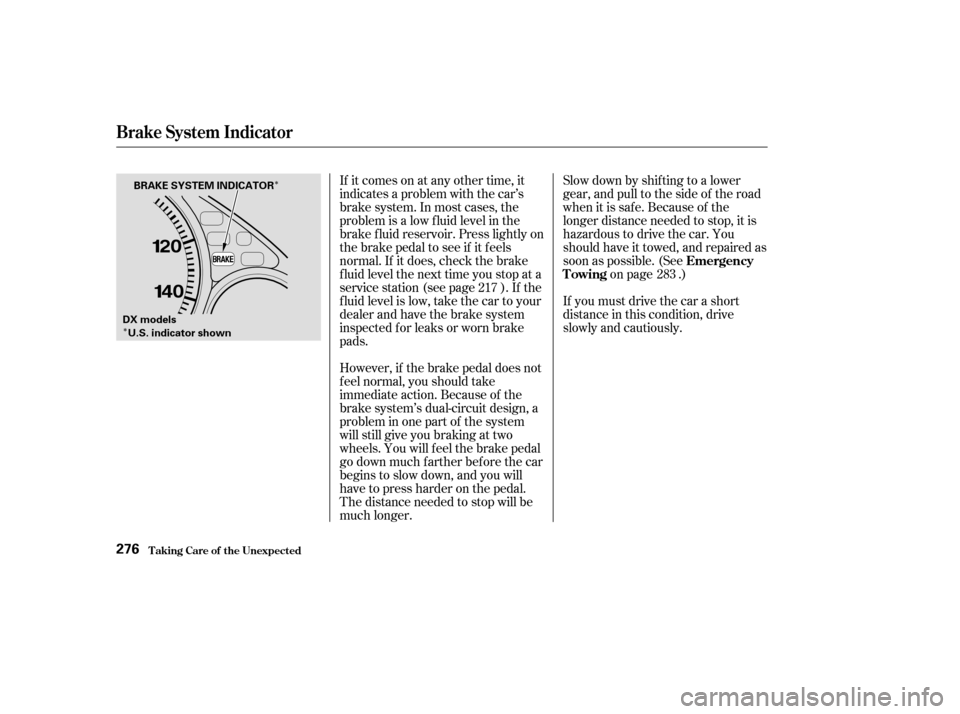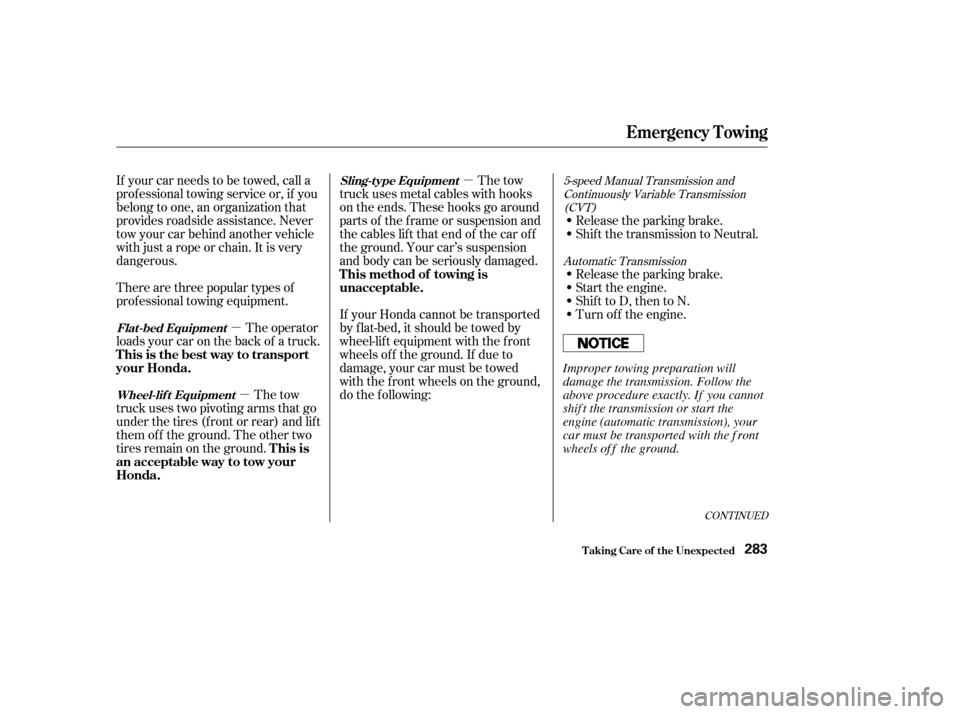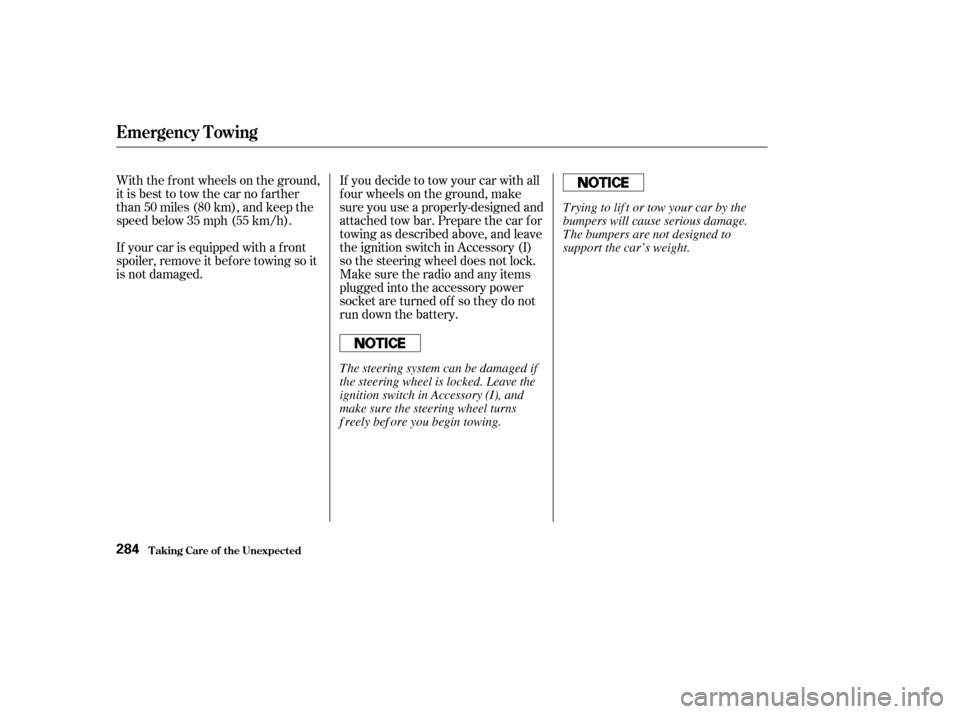Page 252 of 302
CONT INUED
Remove the wheel nuts and wheel
cover. The wheel cover cannot be
removed without f irst removing
the wheel nuts. Do not attempt to
f orcibly pry the wheel cover of f
with a screwdriver or other tool.
Use the extension and wheel
wrench as shown to raise the car
until the f lat tire is of f the ground.
Remove the f lat tire. Temporarily
place the f lat tire on the ground
with the outside surface of the
wheel f acing up. You could scratch
the wheel if you put it f ace down.
9.
10. 11.
Changing a Flat T ire
T aking Care of t he Unexpect ed261
WHEEL WRENCH EXTENSION WHEEL
NUTS
WHEEL NUTS WHEEL COVER
�����—�����—�����y�
�������������y���
�(���%�������y���������y
Page 253 of 302
Lowerthecartothegroundand
remove the jack.
Put on the spare tire. Put the
wheel nuts back on f inger-tight,
then tighten them in a crisscross
pattern with the wheel wrench
until the wheel is f irmly against
the hub. Do not try to tighten
them f ully.
Bef ore mounting the spare tire,
wipeanydirtoff themounting
surface of the wheel and hub with
a clean cloth. Wipe the hub
carefully,itmaybehotfrom
driving.
12. 13.
14.
T aking Care of t he Unexpect ed
Changing a Flat T ire
262
BRAKE HUB
�����—�����—�����y�
�������������y���
�(���%�������y���������y
Page 254 of 302
Tighten the wheel nuts securely in
the same crisscross pattern. Have
the wheel nut torque checked at
the nearest automotive service
f acility.
Tighten the wheel nuts to:Place the flat tire face down in the
spare tire well.
Remove the spacer cone f rom the
wing bolt, turn it over, and put it
back on the bolt.
Secure the f lat tire by screwing
the wing bolt back into its hole.
Remove the center cap before
storing the f lat tire in the trunk
well.
15. 16. 17.
18. 19.
CONT INUED
On HX and EX models in the U.S., Simodel in Canada
Changing a Flat T ire
T aking Care of t he Unexpect ed263
WING BOLT SPACER CONE
80 lbf·ft (108 N·m , 11 kgf·m)
�����—�����—�����y�
�������������y���
�(���%�������y���������y
Page 255 of 302
Store the jack in the trunk with the
end bracket on the lef t side. Turn
the jack’s end bracket to lock it in
place. Store the tool kit.
Store the wheel cover in the trunk.
Make sure it does not get
scratched or damaged.
Lower the trunk f loor, then close
the trunk lid.
20.
21.
22.
Changing a Flat T ire
T aking Care of t he Unexpect ed264
Loose items can fly around the
interior in a crash and could
seriously injure the occupants.
Store the wheel, jack, and tools
securely before driving.
�����—�����—�����y�
�������������y���
�(���%�������y���������y
Page 267 of 302

�Î
�ÎSlow down by shif ting to a lower
gear, and pull to the side of the road
when it is saf e. Because of the
longer distance needed to stop, it is
hazardous to drive the car. You
should have it towed, and repaired as
soon as possible. (See on page .)
If you must drive the car a short
distance in this condition, drive
slowly and cautiously.
If it comes on at any other time, it
indicates a problem with the car’s
brake system. In most cases, the
problem is a low f luid level in the
brake f luid reservoir. Press lightly on
the brake pedal to see if it f eels
normal. If it does, check the brake
f luid level the next time you stop at a
service station (see page ). If the
fluid level is low, take the car to your
dealer and have the brake system
inspected f or leaks or worn brake
pads.
However, if the brake pedal does not
f eel normal, you should take
immediate action. Because of the
brake system’s dual-circuit design, a
problem in one part of the system
will still give you braking at two
wheels. You will f eel the brake pedal
go down much f arther bef ore the car
begins to slow down, and you will
have to press harder on the pedal.
The distance needed to stop will be
much longer. 217
283Emergency
Towing
Brake System Indicator
T aking Care of t he Unexpect ed276
BRAKE SYSTEM INDICATOR
DX models U.S. indicator shown
�����—�����—�����y�
�������������y���
�(���%�������y���������y
Page 274 of 302

�µ
�µ �µ
The tow
truck uses two pivoting arms that go
under the tires (f ront or rear) and lif t
them of f the ground. The other two
tires remain on the ground.
If your car needs to be towed, call a
prof essional towing service or, if you
belong to one, an organization that
provides roadside assistance. Never
tow your car behind another vehicle
with just a rope or chain. It is very
dangerous.
There are three popular types of
prof essional towing equipment.
The operator
loads your car on the back of a truck. The tow
truck uses metal cables with hooks
on the ends. These hooks go around
parts of the f rame or suspension and
the cables lif t that end of the car of f
the ground. Your car’s suspension
and body can be seriously damaged.
If your Honda cannot be transported
by f lat-bed, it should be towed by
wheel-lif t equipment with the f ront
wheels of f the ground. If due to
damage, your car must be towed
with the f ront wheels on the ground,
do the f ollowing: Release the parking brake.
Start the engine.
ShifttoD,thentoN.
Turn of f the engine.
Release the parking brake.
Shif t the transmission to Neutral.
Automatic Transmission
5-speed Manual Transmission and
Continuously Variable Transmission(CVT)
CONT INUED
Wheel-lif t Equipment
Flat -bed Equipment Sling-t ype Equipment
T his is
an acceptable way to tow your
Honda.
This is the best way to transport
your Honda.
T his method of towing is
unacceptable.
Emergency T owing
T aking Care of t he Unexpect ed283
Improper towing preparation will
damage the transmission. Follow the
above procedure exactly. If you cannot
shif t the transmission or start the
engine (automatic transmission), your
car must be transported with the f ront
wheels of f the ground.
�����—�����—�����y�
�������������y���
�(���%�������y���������y
Page 275 of 302

If you decide to tow your car with all
f our wheels on the ground, make
sure you use a properly-designed and
attached tow bar. Prepare the car for
towing as described above, and leave
the ignition switch in Accessory (I)
so the steering wheel does not lock.
Make sure the radio and any items
plugged into the accessory power
socket are turned of f so they do not
rundownthebattery.
With the f ront wheels on the ground,
it is best to tow the car no farther
than 50 miles (80 km), and keep the
speedbelow35mph(55km/h).
If your car is equipped with a f ront
spoiler, remove it bef ore towing so it
is not damaged.
Emergency T owing
T aking Care of t he Unexpect ed284
Trying to lif t or tow your car by the
bumpers will cause serious damage.
The bumpers are not designed to
support the car’s weight.
The steering system can be damaged if
the steering wheel is locked. Leave the
ignition switch in Accessory (I), and
make sure the steering wheel turns
f reely bef ore you begin towing.
�����—�����—�����y�
�������������y���
�(���%�������y���������y
Page 278 of 302

�Î�Î�Î �Î �Î�Î�Î�Î
�Î �Î
�Î �Î
�Î �Î �Î�Î
�Î
�Î�Î
Specif ications
T echnical Inf ormation288
Dimensions
Weights
Engine Capacities
174.7 in (4,438 mm)
66.7 in (1,695 mm)
55.1 in (1,399 mm)
103.1 in (2,620 mm)
57.9 in (1,470 mm)
57.9 in (1,470 mm)
2.95 x 3.72 in (75.0 x 94.4 mm) 13.2 US gal (50
)
102 cu-in (1,668 cm
)
9.5 9.9
Length
Width
Height
Wheelbase
Track
Gross vehicle weight rating See the certification label attached
to the driver’s doorjamb.
Type
BorexStroke
Displacement
Compression ratio
Spark plugs Water cooled 4-stroke
SOHC , SOHC VTEC
4-cylinder gasoline engine
Excluding the oil remaining in the engine.
Including the coolant in the reserve tank and that remaining in the
engine.
Reserve tank capacity: 0.108 US gal (0.41
)
4.8 US qt (4.5
)
2.6 US qt (2.5)
6.0 US qt (5.7)
6.3 US qt (6.0)
3.4 US qt (3.2)
2.9 US qt (2.7)
1.7 US qt (1.6)
1.6 US qt (1.5)
4.4 US qt (4.2)
3.5 US qt (3.3)
3.2 US qt (3.0)
3.7 US qt (3.5)
3.4 US qt (3.2)
Fuel tank
Engine
coolant
Engine oil Automatic
transmission
fluid 1.03 US gal (3.9
)
1.00 US gal (3.8)
1.00 US gal (3.8)
1.32 US gal (5.0
)
1.29 US gal (4.9)
1.29 US gal (4.9)
See spark plug maintenance
section page 221 .
FrontRear
Approx.
U.S.: HX, EX
Canada: Si HX
DX, LX
EX, HX
3: 4: 5:6:
7:
DX, LX
1:2: Change
ManualAutomaticCVT
Total ManualAutomaticCVT
Change Including
filter
Without filter
Total
ChangeTotal
Change Total
U.S. Cars
Canada Cars
12
12 5656
7 7
3 4
Manual trans-
mission fluid
Windshield
washer reservoir
�����—�����—�
���y�
���������
���y���
�(���%�������y�������
�y